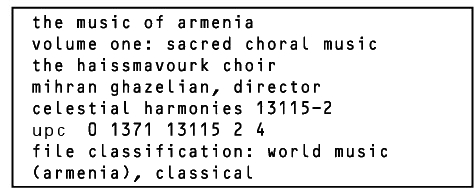


the project
The Music of Armenia focuses much of its six
volumes on the sacred and folk music traditions of the Eastern Armenians.
It was recorded mostly within the modern republic. The only exception
was the folk music of the disputed Nagorno-Karabakh region, which
was recorded inside that strife-torn area in Azerbaijan.
The Music
of Armenia, as substantial as it is, in fact began as a musical
detour. The intrepid New Zealand composer, David Parsons, who has
previously produced
The Music of Cambodia (
19902)
and
The Music of Vietnam (
19903) was
working on another project for Celestial Harmonies titled,
The
Music of Islam (
19907), when Celestial
Harmonies' president, Eckart Rahn, asked if he had heard the monastic
choirs of Armenia. Parsons set off to investigate: once there, he
says, "I was struck by the extremely high level of development
in all the music I was hearing. For me, personally, this was the most
outstanding traditional music I had heard."
The recent explosion of interest in Gregorian Chant
and in the mystical music of various, mostly Eastern European composers,
suggests that there is something in modern Western life that has listeners
searching for the ancient, or, perhaps timeless sounds, of sacred
music. The sacred choral music heard on The Music of Armenia, Volume
One: Sacred Choral Music certainly fits the bill.
the artists
The choir performing on The Music of Armenia, Volume
One is the Haissmavourk of Gtoutiun, A.B.U., or, in English, Haissmavourk
of Charity. The A.B.U. designation refers to the American Benevolent
Union, a private American trust at work in Armenia. The choir, which
performs, and is famous throughout Armenia, was created in 1990 and
only sings sacred music.
The choir's musical director, Mihran Ghazelian was
born in Beirut, but had his musical education in Armenia. He is also
the musical director and conductor of the Echmiadzin Cathedral. He
is both a conductor and musicologist and has toured as conductor of
Armenian choirs in Canada and England.
Ghazelian is also a graduate of the Komitas State Conservatory,
Yerevan. The conservatory's namesake, Komitas Vardapet (1869-1935),
was the arranger of many of the tracks on The Music of Armenia,
Volume One as well as many tracks on the other five volumes. Armenian
music has it roots in Eastern traditions and is not bound by the rules
of Western music. Komitas had the idea of making this music polyphonic
and subsequently arranged hundreds of folk songs that he collected
from the villages.
tracklist
| 1 |
Aravot lousaber (Ascending light.) |
3'15" |
| 2 |
Aysor dzainen (Hymn for the blessing of the water.) |
2'51" |
| 3 |
Bats mez ter (Open for us.) |
2'36" |
| 4 |
Hayrapetakan maghtan (Prayer to the patriach.) |
2'27" |
| 5 |
Yekyalks (We are gathered.) |
3'45" |
| 6 |
Hyer mer (The Lord's Prayer.) |
2'42" |
| 7 |
Havoun havoun (About the bird.) |
3'52" |
| 8 |
Sirt im sasani (My heart is trembling.) |
4'31" |
| 9 |
Yerg votnlvai (1) (Hymn for the washing of the
feet.) |
2'07" |
| 10 |
Ov zarmanali (What a miracle.) |
2'33" |
| 11 |
Hreshtakayin (Hagiological hymn.) |
3'11" |
| 12 |
Metsatsoustseh (Synaxical hymn.) |
0'52" |
| 13 |
Yerg votnlvai (2) (Hymn for the washing
of the feet.) |
3'01" |
| 14 |
Hayr arakogh (Hymn for the feast of the Apostles.) |
3'17" |
| 15 |
Our es myer im (Where are you, my mother.) |
3'32" |
| 16 |
Khachi ko Ktistos (To Christ's cross.) |
8'28" |
| 17 |
Yekeghetsin haikakan (The Armenian Church.) |
3'22" |
| 18 |
Marmin terounakan (1) (The Lord's body.) |
1'27" |
| 19 |
Chanapar (The way.) |
1'40" |
| 20 |
Echmiadzin |
2'11" |
| 21 |
Varanimk (Melody for the Feast of Assumption.) |
4'07" |
| 22 |
Marmin terounakan (2) (The Lord's body.) |
1'24" |
| 23 |
Bashkheh zharmin (Chant of Communion.) |
0'50" |
| 24 |
Ter voghormya (God forgive us.) |
5'00" |
| |
Total Time: |
75'00" |








